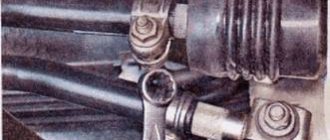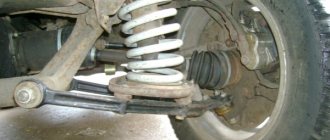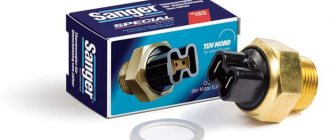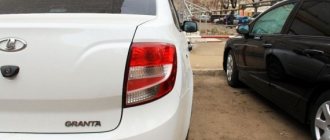Backlash is a term in mechanics that implies the presence of free movement in an element of a mechanical system. It represents a parameter by which one can judge the amount of movement of the node mentioned above to obtain a response from another - the controlled node.
In other words, the amount of backlash is characterized as the amount of rotation or displacement of the controlled element, which does not lead to any changes in the object.
In relation to a car and steering, the angle of rotation of the steering wheel at which the car continues to move in the same direction.
What is meant by total steering wheel play?
Another term that requires consideration is “total backlash.” It refers to the total angle, which starts from the extreme position of the steering wheel on one side when turning begins, to the opposite position when the car starts moving in the other direction.
To understand the principles of operation of the total backlash, it is important to understand the design and operating features of the control system. Based on the technical component, the operating principle of the backlash is as follows.
There is a rod in the transmission of steering rods, which is fixed with a small gap of one or two millimeters.
This distance is necessary to protect the steering system linkages from wear due to excessive friction.
The presence of a gap is a technological solution that allows you to keep the hook in the required position and not touch the surface of the teeth.
For the driver, this parameter represents free movement of the steering wheel, which allows for more precise control of the car and to feel at what moment the direction of movement of the vehicle changes.
Essentially, this is the total distance the steering wheel travels before the car moves to the left or right.
Many people mistakenly consider this phenomenon negative and try to get rid of it. You shouldn’t do this, because play in the steering is the norm for every car. Another thing is that it must have a strictly defined value.
An interesting pattern can be traced here - the larger the car’s dimensions, the higher the backlash indicator.
In the process of measuring the total backlash, a number of conditions must be met:
- The front wheels are located in a neutral position and stand on a hard (asphalt or concrete) surface.
- The steering wheel tires are dry and clean.
- The car engine is started. This is relevant if the operation of the power steering is tested.
- The tension of the power steering pump drive belt, as well as the level of the working fluid, must meet the requirements approved by the manufacturer.
The total play is checked by measuring the angle of rotation of the control wheel between the fixed positions for changing movement to the left and right.
To obtain accurate parameters, measurements are made two or more times.
What is steering play, how to determine it and fix it yourself
Control problems, along with brake failures, are the worst things that can happen to a car in motion. The real harbinger of such problems is steering play. Let's figure out what it is and how to protect yourself.
So, play is a flaw in the steering. It occurs due to problems with the steering rack, or the calibration of the steering wheel itself. Essentially, this is a poor reaction of the wheels to turning the steering wheel, which is expressed in the form of a reserve.
To put it simply: if you turn the steering wheel to the side, but the wheels do not react immediately, this is the same play. It’s worth noting right away that many manufacturers provide a slight free play of the steering wheel, without “hooking” the wheels themselves. You can find out the corresponding freewheel parameters in the technical documentation of your vehicle.
Other troubles
In addition to backlash, you should be attentive to other troubles associated with turning and steering:
- Increasing effort. If you notice that you need to apply more and more force to the steering wheel in order to make a turn, then this is also a sign of a problem. This happens due to wear of the rack or gearbox.
- Spontaneous deviation. Let's assume that you parked your car in the evening, leaving the steering wheel strictly in the center. In the morning, getting into the cabin, you noticed that it was tilted, while the wheels remained straight.
- Leaks. Liquid can leak both from the rack seal and from the power steering barrel. You can find them under your car, or during a self-inspection in a pit.
If one of these aspects is detected, we recommend immediately contacting the service and checking the mechanisms. One diagnostic that you pay for can save not only your future budget, but also the health and life of you and your passengers.
Tolerance
As we have already said, automakers set the permissible amount of play. It is usually 2-3 millimeters, or degrees of slope. They are necessary so that the control mechanisms are not under constant pressure and, accordingly, last longer due to less wear.
The norm is prescribed in the technical documentation, but it may be different for different vehicles. Usually for buses and trucks it is slightly higher, again, due to the greater load on the steering rack. For passenger cars it is limited to a couple of degrees.
Examination
Checking the play can be carried out either independently or with the help of service specialists. In order to find out the value yourself, you will need a ruler, some kind of marker or chalk and the attentive eye of an assistant.
- Set the steering wheel to a normal, straight position. You can determine it using a ruler with a water capsule, the so-called level.
- Having placed the steering wheel, we make a mark at the very top of it. We place a regular ruler in front of the steering wheels. We compare the mark with the reading on the ruler. Let's say we got the mark to be at 15 centimeters.
- Then, we slowly turn the steering wheel, counting the centimeters by which we have deviated. For example, we rotate it to the left, which means our mark will approach 14 centimeters and further.
- Our observer watches the wheels and signals when they have moved. When we received his command, we stop the rotation and record the indicator. Let's say our mark remains at 13.5 centimeters. This means the play is 1.5 centimeters.
- This work can be ideally done using a protractor. You just need a big one, something like what engineers and architects use. It can be purchased in the office supply department. The principle is the same, but the data obtained will be in degrees, which suits us better.
At a service station, such work is carried out using a special device - a backlash meter. This is a small computer that connects to the steering wheel and calculates the deviations itself. Naturally, it is much more accurate and gives a better picture of the situation and the necessary corrections. With its help, the total play of the steering wheel is calculated. If the documentation does not allow it, then we need to move on to correction.
How to fix
What to do if the indicators are critical? Of course, eliminate the found play. The main reasons are in the steering column. She can betray her illnesses not only with deviations, but also with a corresponding knock. You will most likely notice the knocking only when the deviation is already large enough and adjustment is needed.
It is not possible to completely remove free play; remember the necessary margin to extend the service life of parts. We need to reduce it until we reach critical levels. Therefore, we climb into the area of the steering rack.
Task: tighten up all the parts and replace such consumables. Take a wrench or hexagon. We find the nuts that secure the spare part. It will be located next to the oil seals or other rubber elements. We need to adjust these nuts.
Permissible backlash in cars
The traffic regulations stipulate normalized indicators of total play for various cars. In addition, this parameter should not exceed the figures specified in the documentation for the operation of the machine.
If there are no special recommendations in the manufacturer’s papers, the backlash should be as follows:
- For passenger cars, as well as bus and truck components made on their basis - 100;
- For buses - 200;
- For trucks - 250.
There are also separate recommendations for some models:
- For VAZ-2106, 2107, 2110, 21213 - 50;
- For Gazelle 3302 - 200 (passenger version) and 250 (truck).
Reasons for large backlash
The increase in play can be explained by changes in the design features of the steering, as well as the destruction of their elements.
The main reasons include:
- Worn gear bar and steering rack gear teeth.
- Damage or deformation of the wheel bearing. There are cases when it falls apart during operation, which leads to an increase in backlash (but there will be no time for backlash).
- Malfunction of tips and tie rods, which often break if operating requirements are not followed. The result is the same as in the previous case - “looseness” of the steering wheel.
- Poor quality repair of the vehicle chassis. There are situations when steering play manifests itself after visiting a service station. This is possible when service technicians do not tighten the wheel bearing nut sufficiently. As a result, the car's steering system suffers.
- Breakage of the ball joint (lower or upper), as well as pulling the steering rack with excessive force.
- Outdated hydraulic oil that requires replacement. Often play in the steering is eliminated after filling with new working fluid.
Generally speaking, play occurs when there is a fault in the chain between the steering wheel and the wheels.
To find out the reason, you need to go through the entire chain and identify the “weak” points. The main thing is to make sure that we are talking about increased free play, and not about other problems.
Other causes of play in the steering include:
- Wear or incorrect adjustment of the engagement of the “worm” and the roller mechanism.
- Worn swing arm axle or bushings.
- Loose crankcase fasteners.
Principle of operation
To understand what steering play is, consider the principle of operation of steering systems in a modern car. The steering wheel is connected through a cardan joint to a mechanism that is a hollow (usually duralumin) tube, inside of which there is a gear rack moved by a gear connected to the cardan joint. The rack is connected through internal tips to rods, which are connected through external hinges to the steering arms on the front suspension struts. Thus, any movement of the rack leads to the rotation of the wheels and any play in the steering can lead to serious consequences from a delayed reaction to movement to a complete loss of control of the car.
We recommend: Boiling point of antifreeze and antifreeze
Reasons for play in the steering:
- poor tightening of the steering wheel nut;
- wear of spline joints;
- wear of the cardan joints of the intermediate shaft;
- loosening of the steering mechanism to the body;
- increased gap between the rack and gear in the mechanism;
- tip wear;
- wear of the rubber-metal hinges securing the rods to the mechanism or weakening of their fastening bolts;
- loosening the adjusting rods.
The play may be accompanied by a knocking sound in the steering column, which may indicate wear of the parts.
Signs of breakdown
As noted above, in order to effectively eliminate a malfunction, it must be diagnosed in a timely manner. To do this, it is enough to know the signs of play in the steering.
The main symptoms include:
- The appearance of a knock in the steering mechanism;
- Increased vibrations while driving;
- Creaking when turning wheels;
- Deviation from a given trajectory when the steering wheel is in a straight position.
When adjusting the steering play, you should take into account the manufacturer’s recommendations and traffic rules.
The configured parameter should not exceed the upper limit, but you should not underestimate the indicator either.
Too little steering wheel play can lead to additional discomfort and poor vehicle controllability.
At the same time, you should not ignore the appearance of a small backlash, because over time this parameter may increase, and then it will be more difficult to deal with the problem.
And it’s inconvenient to drive a car when you constantly have to “catch the road” and turn the steering wheel in one direction or the other.
Also read about the causes of knocking when turning the steering wheel.
What is backlash
The total steering play of any car, including a bus, is the angle by which the steering wheel deviates when turning it left and right, to the point where the bus wheels begin to turn.
Each bus manufacturer indicates the deviation in its documentation for the bus, and the angle obtained as a result of field tests should not be greater than specified.
If the value is not indicated in the documentation, then in fact it should not be greater than the value established in state regulations.
The backlash value is set for each type of vehicle, including buses, and it should be:
- passenger vehicles – 10 degrees;
- buses - 20 degrees;
- trucks – 25 degrees.
Diagnosis of the problem and instruments used
To determine whether the parameter corresponds to the norm, you need to do a small check.
To make sure there is a problem, you can use a special device - a backlash meter.
With its help you can check the total (total) play in the system.
One of the device options is K 524 M or ISL-M, which can be used by ordinary car owners and professionals at service stations.
Using a backlash meter, it is possible to determine the amount of free play in just three minutes, including taking into account installation and removal of the device.
The algorithm for diagnosing steering play is as follows:
- Start the engine (it should be idling);
- Place the front wheels parallel to the longitudinal axis of the machine. At the same time, make sure that the hydraulic booster is working;
- Turn the steering wheel one way and then the other. At this moment, record the moments when the front wheels begin to scroll in the required direction. The distance that the steering wheel travels between these intervals is called play (free play).
This check is considered an excellent option for drivers who need accurate and quick information.
It does not matter how the problem was diagnosed. If the steering play exceeds the norm, it must be eliminated.











